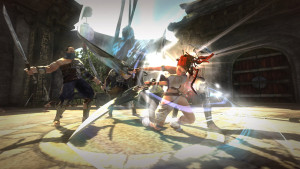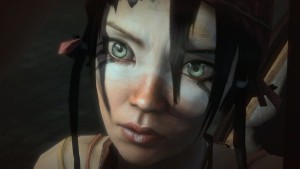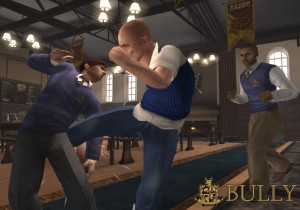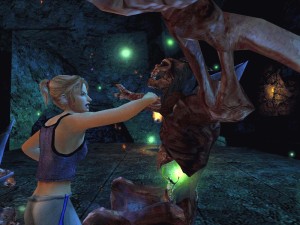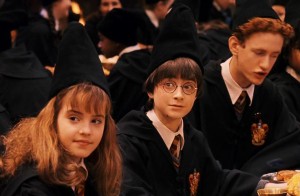`Things have been really crazy lately at Surreal, but in spare moments I’ve been thinking about Rick’s manifesto on Japanese games and what it means to me. Certainly a great deal of the debate is personal taste… The cultural differences in the east that gain us interesting premises and memorable characters also net us irritatingly angst-ridden heroes, preachy monologues, immersion-breaking cutesy sidekicks, and existential, introspective endings. I had a similarly inspired discussion this week with some of the guys on the virtues of stealth games. Some love them, some hate them.
Somewhat coincidentally, I’ve been immersing myself in the work of three different continents lately: Bioshock, Overlord and Persona 3. While perhaps they are not completely iconic of the values of their respective region-coding, they certainly reminded me of some of the cultural differences I’ve seen in their products over the years. Here are some broad, possibly unfair generalizations on the qualities of Japanese and American games:
- Japanese games tend to mix up settings, so that fantasy is often mixed with sci-fi, psionics, westerns, or whatever. The setting and content often just serve the game creator’s style, creating a certain type of character, or having some sort of visual impact, even if explanations are thin.
- Content is experienced in a fairly linear fashion, even in open-ended RPG’s. Major events are always presented in order, as there is no expectation of “the player writing their story”. The player is definitely being “spoken for” by the mostly mute main character.
- Characters are strongly defined, very early in the game. Each has a distinct look and clearly identifiable motivations. Even when the game has customization of equipment, it tends to not interfere with the character’s graphic. Whether he or she is wearing a feathered cap or a robot helmet, they still appear in the stylish outfit the character designer created.
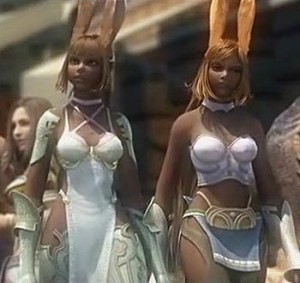 All characters, including NPC’s, tend to wear their heart on their sleeves and spew forth their deepest motivations at the drop of a hat. Cute characters or awkward females are frequently included as tension-relievers.
All characters, including NPC’s, tend to wear their heart on their sleeves and spew forth their deepest motivations at the drop of a hat. Cute characters or awkward females are frequently included as tension-relievers.- The first hour of the game often comes near to playing itself, with an extremely tightly controlled experience. From Square RPG’s to Mario, the Japanese slowly dole out setting and mechanics, even if it takes several hours.
- Gameplay tends to be compartmentalized into smaller game areas in the interest of a simpler interface and smooth visuals. Interfaces vary depending on the game mode, with no fear of menus, overmaps, or stopping the action to allow the player to focus on a single decision.
- Japan has an element of “fantasy” in most games. Suspension of disbelief is not a concern with unusual additions to a fiction. The visual and stylistic impact on these choices seems to take precedent over world consistency. Japanese don’t seem to expend much energy on explaining why the world is normal except for one weird element, or why one member of the party is a giant anteater, and the audience just lets it roll over them.
- The locations in Japanese games are varied, but very often involve abstract interpretations of public spaces. A busy downtown street will be depicted even if the engine can’t support more than 5 NPC’s to occupy it and the camera must be kept top-down to avoid looking at the horizon. This is sufficient, however, to the gamer.
- While they may seem to defy typical American genres, Japanese games have their own that get followed with some fairly specific guidelines as well: Turn-based RPG, Action RPG, card battle, screen-based sim (from horse racing to dating), turn-based strategy, and so on.
United States:
- Americans tend to expect more of a consistent feel from their settings, with fantasy, western, or modern day delivered with certain expectations. When settings are mixed, there tends to be more energy spent explaining why when the Japanese seem to accept each new world.
- Player choice is a highly valued in American games, even if it isn’t delivered all the time. The player’s ability to take an environment and solve it the way he wants to is very important to the public. This usually puts an emphasis on gameplay or mechanics, but this choice is often to the detriment of storytelling.
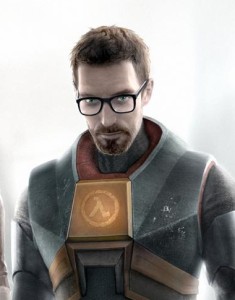 U.S. games tend to take characters to the extremes… Either the game is about the main character, which forms the nucleus of a game’s style, such as God of War, or the character is pushed into the background, making the environment or the gameplay the “main character”, such as in Bioshock or Half-Life. Character customization is valued so the player can be anyone, which detracts from visual design as well as strong player motivations as portrayed in cutscenes.
U.S. games tend to take characters to the extremes… Either the game is about the main character, which forms the nucleus of a game’s style, such as God of War, or the character is pushed into the background, making the environment or the gameplay the “main character”, such as in Bioshock or Half-Life. Character customization is valued so the player can be anyone, which detracts from visual design as well as strong player motivations as portrayed in cutscenes.- The first hour of an American game is focused on “netting the player”, with awareness that the audience may have several games vying for his attention. A great deal of choice and ability is thrown at the player in short fashion to make sure that they understand everything the game is about quickly.
- First-person perspective is also highly valued in American games. These titles universally push the main character into the background, allowing the player to be that individual.
- American games are strongly focused on presenting a continuous experience for the player, with few menus or load times, and game controls and interface that must serve combat as well as during exploration. Menus are kept to a minimum, and real-time battles are always expected in the game world, leading to a more complicated control scheme. Online is also a strong virtue, which almost requires a continuous experience to be functional.
- Settings in American games also are frequently pushed to areas that the designer can control without protest from the player. A dense city for example is often avoided because they are hard to deliver without the compartmentalizing practices of Japanese games. This can lead to more freely explorable games with a far lower visual fidelity, such as Grand Theft Auto III.
- Ironically, however, Americans are influenced by mass media to be more attracted to “realistic” settings and subject matter. Film and TV fall into modern settings even when they explore the fantastic, from Quantum Leap to Bruce Almighty) Unfortunately, while theses settings make it easier for filming TV and movies, they are harder for U.S. gamemakers to place continuous experiences in (in a way that satisfies designers and audiences). Americans are much less interested in suspension of disbelief.
- American games tend to more readily associate “settings” with “genre” than the Japanese. A fantasy game often has a certain set of gameplay expectations, as does a modern military or crime game.
- Action in American games almost universally means combat because they are astronomically easier to put into real-time continuous experiences. And since there is so much pressure to set games in the modern day, the conversation usually turns to guns, because Americans can’t imagine a society that guns are not a part of.
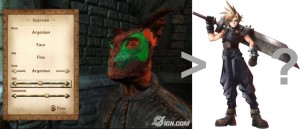 I’m not here to simply rebut Rick and say that Western games are superior (maybe someone else will do that!). One common point of contention between those that enjoy Japanese games versus American ones is how stories are told. Japanese games get all that character data out to the audience quickly, and get right to the drama between them. The dialogue will often include long drawn out exposition on a given character’s motives, and generally those motives are not too deep. American developers are influenced by western cinema that places artistic value on subtlety, slow tension-building and multi-layered character depth. Sadly enough, these techniques are hostile to the average game-player’s patterns… Delivering a punchline to a joke that was set up only ten minutes of cinema-time doesn’t take into the account the chance that the player quit, saved, and waited for two weeks before picking up the game again. The player might miss the several subtle cues that told us that the main character is already dead, or whatever. Sometimes it’s frustrating enough during the development process that many developers either cut all the interesting side-plots before ship, or just fall back on summer blockbuster conventions, which leads to more guns and explosions.
I’m not here to simply rebut Rick and say that Western games are superior (maybe someone else will do that!). One common point of contention between those that enjoy Japanese games versus American ones is how stories are told. Japanese games get all that character data out to the audience quickly, and get right to the drama between them. The dialogue will often include long drawn out exposition on a given character’s motives, and generally those motives are not too deep. American developers are influenced by western cinema that places artistic value on subtlety, slow tension-building and multi-layered character depth. Sadly enough, these techniques are hostile to the average game-player’s patterns… Delivering a punchline to a joke that was set up only ten minutes of cinema-time doesn’t take into the account the chance that the player quit, saved, and waited for two weeks before picking up the game again. The player might miss the several subtle cues that told us that the main character is already dead, or whatever. Sometimes it’s frustrating enough during the development process that many developers either cut all the interesting side-plots before ship, or just fall back on summer blockbuster conventions, which leads to more guns and explosions.
As I touched upon in my post on Children of Men, brisk, bold, simple storytelling is probably the best thing for games. For all the posturing and monologues seen in Japanese games, they are getting the information out to the player and reinforcing it multiple times. The player will certainly remember Cloud and Dante more than Garrett or even Gordon Freeman. Ironically, when an American game guns for a memorable character like Kratos in God of War, the game ends up being more linear, with a clear character who is not bashful about his motives… In other words, it creates an experience like the Japanese have been doing for years.



